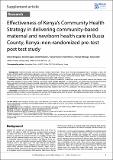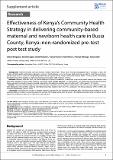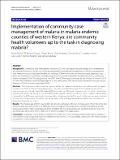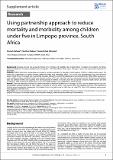| dc.contributor.author | Wangalwa, Gilbert | |
| dc.contributor.author | Cudjoe, Bennett | |
| dc.contributor.author | Wamalwa, David | |
| dc.contributor.author | Machira, Yvonne | |
| dc.contributor.author | Ofware, Peter | |
| dc.contributor.author | Ndirangu, Meshack | |
| dc.contributor.author | Ilako, Festus | |
| dc.date.accessioned | 2021-08-17T08:57:53Z | |
| dc.date.available | 2021-08-17T08:57:53Z | |
| dc.date.issued | 12/26/2012 | |
| dc.identifier.citation | Gilbert Wangalwa, Bennett Cudjoe, David Wamalwa, Yvonne Machira, Peter Ofware, Meshack Ndirangu, Festus Ilako. Effectiveness of Kenya’s Community Health Strategy in delivering community-based maternal and newborn health care in Busia County, Kenya: non-randomized pre-test post test study. Pan Afr Med J. 2012;13(Supp 1):12 | en_US |
| dc.identifier.issn | 1937-8688 | |
| dc.identifier.uri | http://dspace.amref.org/handle/123456789/66 | |
| dc.description | This article is published as part of the supplement “AMREF´s evidence in advancing the health of women and children”
Supplement sponsored by AMREF - African Medical and Research Foundation
© Gilbert Wangalwa et al. The Pan African Medical Journal - ISSN 1937-8688. This is an Open Access article distributed under the terms of the Creative Commons Attribution License (http://creativecommons.org/licenses/by/2.0), which permits unrestricted use, distribution, and reproduction in any medium, provided the original work
is properly cited. | en_US |
| dc.description.abstract | Background: Maternal mortality ratio and neonatal mortality rate trends in Kenya have remained unacceptably high in a decade. In 2007, the
Ministry of Public Health and Sanitation adopted a community health strategy to reverse the poor health outcomes in order to meet Millennium Development Goals 4 and 5. It aims at strengthening community participation and its ability to take action towards health. The study aimed at evaluating
the effectiveness of the strategy in improving maternal and neonatal health outcomes in Kenya.
Methods: Between 2008 and 2010, the African Medical and Research Foundation implemented a community-based maternal and newborn care
intervention package in Busia County using the community health strategy approach. An interventional, non-randomized pre-test post test study
design was used to evaluate change in essential maternal and neonatal care practices among mothers with children aged 0 - 23 months.
Results: There was statistically significant (p<0.05) increase in attendance of at least four antenatal care visits (39% to 62%), deliveries by skilled
birth attendants (31% to 57%), receiving intermittent preventive treatment (23% to 57%), testing for HIV during pregnancy (73% to 90%) and
exclusive breastfeeding (20% to 52%).
Conclusion: The significant increase in essential maternal and neonatal care practices demonstrates that, community health strategy is an appropriate platform to deliver community based interventions. The findings will be used by actors in the child survival community to improve current
approaches, policies and practice in maternal and neonatal care. | en_US |
| dc.description.sponsorship | USAID, AMREF in Spain, AMREF in Netherlands,
AMREF in Germany, AMREF in USA, the Ball Family Foundation, the
Ibrahim El-Hefni Technical Training Foundation, the Starr Foundation,
and the Young Green Foundation | en_US |
| dc.language.iso | en | en_US |
| dc.publisher | Pan African Medical Journal | en_US |
| dc.subject | Neonatal care | |
| dc.subject | Maternal care | |
| dc.subject | Community-based care | |
| dc.subject | Community health strategy | |
| dc.subject | AMREF | |
| dc.subject | Community health worker | |
| dc.subject | Busia | |
| dc.subject | Child survival | en_US |
| dc.title | Effectiveness of Kenya’s Community Health Strategy in Delivering Community-based Maternal and Newborn Health Care in Busia County, Kenya: | en_US |
| dc.title.alternative | non-randomized pre-test post test study | en_US |
| dc.type | Article, Journal | en_US |




